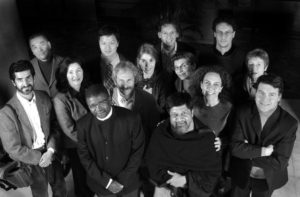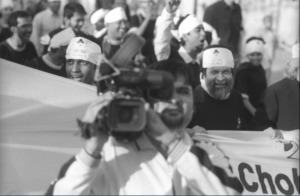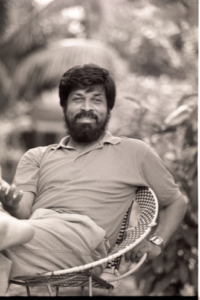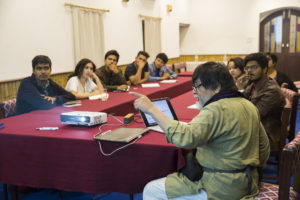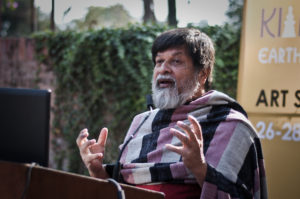
The eye that challenged the status quo
Few are capable of such spontaneous moments of belief, of balancing their ideological positions with practical decision-making, and even fewer can make resources and manpower materialise through their deep roots in both regional and international networks. Alam has become a household name in the photography community because of a unique combination of intimacy, tenacity and vision, and his relentless drive to turn small singular successes into structural change. Alam’s desire for Southasia and the global South to be reflected in the rosters of the international media and the art world is slowly being realised. Lars Boering, the current managing director of World Press, has seen, firsthand, Alam’s persistent rhetoric at international forums against the silencing of the local witness in the global media. As he said in a phone interview from Amsterdam, “His [Alam’s] phrase ‘majority world’ was an eye opener for everybody because there is no argument against it. This argument has stood for twenty years.”
At the time of writing, Alam languishes in jail, detained purportedly for inciting violence through his broadcasts on Facebook during the student protests for road safety in Dhaka. Given his long career as a photographer and documentarian of most major events affecting Bangladesh, it is hardly surprising that Alam was also covering the extraordinary activism of the youth at close quarters. In Bangladesh, it is Alam’s material interventions and constant writing in the press, his vigilance against injustice, which makes him known to the wider public. There, it is not his exhibitions at the Centre Pompidou in Paris or the Museum of Modern Art in New York that matter, but the fact that he played a role in bringing email to his fellow citizens, was at the forefront of grasping the digital revolution, has opened exhibition after exhibition at Drik gallery pointing to taboo subjects and human-rights violations in Bangladesh, and that he counts himself as a social activist first and an artist second.
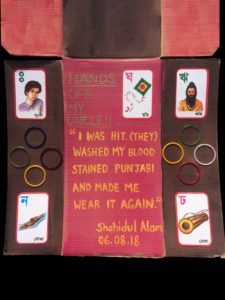
What can I do? I have to keep working, bring attention to the wider cause, as he taught me to do. Never stop. It all started as schoolchildren protesting peacefully. They took it upon themselves to do all the heavy lifting. My uncle always has faith in children. Everyone loves him but children love him best. Never was there more mischievous prankster. He bought these alphabet cards and bangles for my children. I had to hide this poster from them, in case they read what it says. Posted on Instagram by Sofia Karim on 17 August 2018.
Alam has written to successive Bangladeshi prime ministers, fearlessly spelling out the consequences of their lapses in judgment and seeking justice. In 1992, hundreds of thousands of Bangladeshis gathered at Suhrwardy Uddayan, at what Alam called “the site of liberation… for a denunciation of war criminals”. But on television there was no sign of the agitating masses. So Alam wrote to the BNP government protesting “their appropriation of Bangladesh Television; a media that is paid for and rightfully belongs to the people”. His righteous indignation was worded as a reminder to then Prime Minister Khaleda Zia, of her responsibilities to “a citizen of a nation with a democratically elected parliament”. Alam’s epistles are effective because he combines a historical viewpoint with an unfailing ethical compass, and, most importantly, a personal mode of address. This method of writing, with one eye to the future and the other to the past, all the while having both feet firmly planted among the people, is what makes the vast corpus of articles Alam has produced a parallel, personal history of Bangladesh.
This is also what makes his arrest and the continuing vindictive denial of bail by a government headed by Sheikh Hasina Wazed, the daughter of Sheikh Mujibur Rahman – who had led the campaign against the war criminals – a travesty. Rahman’s grandson Sajeeb Wazed Joy has repeatedly, publicly, and vocally denounced Alam.
Alam’s niece Sofia Karim remembers the advice that Alam had given to her as a child, when she felt she had been wronged: “You should be transparent, you should say what you need to say in front of everyone, then the perpetrator has the right to a defense and he can challenge you”. Telling as many people as possible, publicly, and in the presence of the perpetrator is the only route to true resolution, Alam believes. It is precisely this opportunity for transparency that Alam is being denied. Honesty and the power to build solidarity are his biggest assets but also what the government most likely fears.
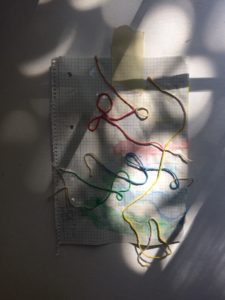
String painting by my incarcerated uncle Shahidul and my daughter, last month. My uncle came to London last month for the V&A Jameel prize (he is on the board of nominees). Despite his busy schedule he makes time for my children. He took my daughter to the garden and they made paintings. He was happy when he saw me put it up on my studio wall. Light and shadow pass over the wall. My uncle loves to observe light and shadow with his lens. By now he will have memorised the play of whatever light falls on the walls of his cell. Posted on Instagram by Sofia Karim on 11 August 2018.
His incarceration has mobilised not just colleagues, friends and family, but international protests ranging from Peru to Perpignan, from the doors of the United Nations General Assembly in New York to the press associations of Mumbai and Delhi. With ongoing arrests of civil-society activists and journalists in various Southasian countries, Alam’s imprisonment might seem part of the quotidian round. What is it that makes this man so extraordinary that figures as disparate as Sharon Stone and Archbishop Desmond Tutu, Nobel Laureates, journalists, human rights organisations, artists and photographers across the world have been petitioning and calling for his release?
Beginnings
Born in 1955, Alam’s childhood was marked by the aftermath of Partition, the Bangladesh liberation war, and a weighty intellectual inheritance. Alam’s father, Kazi Abul Monsur was a leading scientist at the Public Health Lab. His mother, Quazi Anwara Monsur, a child psychologist, founded the Agrani Bidya Biddalaya. But the family faced years of financial struggle before they became acclaimed citizens. Writing about his mother in ‘The Last Goodbye’, Alam recounted: “My father’s low paid government salary was simply not enough… Amma’s teaching job, plus the extra income she made from marking exam papers wasn’t enough…She would buy wool from the market and knit sweaters to sell for extra income.” The family’s conditions improved slowly but Alam’s childhood was marked by the tragic suicide of his elder brother Khaled, to whom his autobiographical photobook My Journey as a Witness is dedicated. This real loss was presaged by a figurative loss of familial name, Alam decided to change his name from Zahed Monsur to Shahidul Alam at the behest of his brother as a young boy.
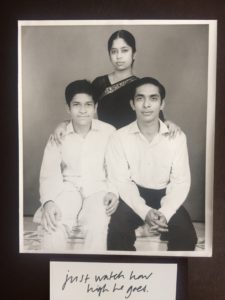
‘Shahidul aged 14 (left hand side), Amma, and Khaled, c. 1969’. There were three siblings, my mother the eldest, Shahidul the youngest. Khaled in the middle, died at the age of 21. ‘Khaled was even brighter than Shahidul’ my mum said, ‘but he would watch Shahidul play, a whirling, mischievous, rascal, and Khaled would say “that one will fly, sister. Just watch how high he goes”’. Shahidul was sent to jail today to await trial. No dates given. Neither he, nor his lawyer were present at court when this decision was taken. That is what I read on the news. Posted on Instagram by Sofia Karim on 14 August 2018.
Alam discovered photography while completing his PhD in Chemistry at University of London. After a chance hitchhiking holiday with a camera in America and Canada, he spent years reading hundreds of books on photography borrowed from British libraries, and months experimenting with alternative photographic processes in the darkroom. During this time, Alam developed a profound awareness of the dignity of human labour as he worked for the first time on construction sites, cleaned toilets, and stood bouncer in nightclubs to pay his way through university. In 1983, he became the recipient of the Harvey Harris Trophy awarded by the London Arts Council. He returned to Bangladesh the next year, continuing the kind of commercial work he had begun to sustain himself in London: portraiture, studio photography, and working for advertising agencies and corporations.
On his return, Alam also began photographing the struggle against General Ershad, the tenth President of Bangladesh (1983-1990), images which evolved into the photo essay A Struggle for Democracy. A Bangladeshi educator and curator, who studied with Alam and has worked with him for over a decade, described A Struggle for Democracy as an iconic photographic narrative because it revealed that images could be used to divulge the deepest divisions and contradictions within Bangladesh: “We Bangladeshis call it our first body of work… for us it’s a very complex narrative because it doesn’t represent one side or the other, it’s trying to see Bangladesh as a whole, as a new nation… through so much struggle and duality… (For example) Indigenous operations were a very sensitive issue… multiple layers (like) Islamisation, national elections, street protest… that was a global introduction of Bangladesh.” A few weeks after Alam’s arrest, the photo essay was re-exhibited at the Drik gallery, a tangible reminder of how long Alam has been at work to give his people a visual history. Importantly, it stood against the local smear campaign attempting to tarnish Alam’s reputation.
By 1987, Alam was the president of the Bangladesh Photographic Society (BPS), a group enamoured by the pictorial salon aesthetic. Though he learned much about Bangladeshi photographic history, Alam soon realized the limitations of the BPS method of stylistic appreciation – it did not bridge the visible gaps in visual literacy, it did not bring the public closer to their reality.
Photography was not a well-paid profession in Southasia during the late 20th century and is still a poorly paid cousin of reportage in the Southasian journalism industry. There was certainly no educational emphasis or critical thinking about the photographic image that had been institutionalised in the region. Globally, photojournalism was notoriously narrow: white, male, and dominated by Western agencies and magazines to which few Southasian photographers could get access. Overcoming these odds, Alam achieved considerable success as a celebrated photographer, recognised in the ranks of the world’s leading photojournalists. But rather than remaining content with an independent success story, as most reputed Southasian photographers of his generation have, Alam chose to embark on the far more laborious process of filling the institutional gaps that would allow the Southasian media community to flourish internationally.
A family of institutions
The first foundation Alam built was an agency and archive called Drik Picture Library that provided photographers with assignments and access to commercial and journalistic work that could make photography a viable middle-class career. Drik, set up in 1989, also brought out publications, initially calendars, which showcased the kind of social and political issues that Alam was interested in addressing. The first calendar, in 1990, represented children at play, at work, as family members, and as protestors, revealing their complex position in Bangladeshi society. That Alam would choose this delicate and difficult subject is not surprising – his respect and regard for children and the special place they hold in his life came up in every interview. Out of Focus is an initiative he founded to give free classes in photography to working class children. In a span of seven years, however, these children went from being the subject of the Drik calendar to wielding cameras and participating in the editorial process. The 1997 Drik calendar Our Lives As We See Itis a reflection of this transformation, the quotes imprinted on each month are from the children and the images are all theirs. Published at a time when such transgressions were rare, it is a resounding document of what we can see if we create the opportunity for a reversal of roles.
This shift is reflective of Alam’s own journey, which grew increasingly self-critical: what was the difference really between a white man looking at a woman in a flooded home through his camera, and a middle-class Bangladeshi man like him making the same photo? What rights had he allowed the subjects of his photographs to exercise? Had he returned to them after the crisis – war, famine, flood – that brought him to their doors, had abated? Weren’t the same international press and the NGOs that he blamed for misrepresenting the country using the images he had taken? Which images mattered to Bangladeshis? These are the questions the first few generations of Alam’s students recall grappling with.
When Alam founded it in 1998, Pathshala South Asian Media Institute was not only rare because it was a medium-centric school, but also because it forced students to reflect on photography from more meaningful perspectives. Visual anthropology and social studies were deemed as essential to an emerging photographer’s practice as dark rooms and lens choices. The curriculum was rebellious in that it did not adhere to the Western canon of photographic development, theoretically or historically. Alam has remained critical of mainstream academic practices that dissociate image from context, art from activism, journalism from responsibility, viewer from viewed. Alam began the school so he could teach photography as a critical rather than a technical practice, and began hosting workshops and classes with some of the world’s leading practitioners. Over the past two decades, students from Pathshala have come to be recognised as some of Southasia’s leading photographic artists. Many have gone on to be recognised internationally, having exhibitions in prominent museums and photographic meccas like Arles and Perpignan, and by becoming teachers and taking the next generations coming into Pathshala in new directions.

‘Had Cadmium ever glowed so red?’ – For my incarcerated uncle, photographer Shahidul Alam, prisoner of conscience. My uncle loved, met and wrote about the late art writer, John Berger. Last month we talked about Berger’s notes on colour in ‘I send you this cadmium red’. This collage is made using a photo taken by Shahidul of the book Berger signed for him. ‘In solidarity’, Berger says. Yes. And what is red now? “…now it is the heaviest red in the world. No bird could fly near it” (John Berger, ‘I Send you This Cadmium Red’) Photo of book by Shahidul Alam, courtesy of Drik. Collage of Cadmium red and stitched cloth, by Sofia Karim, Shahidul’s niece. Posted on Instagram by Sofia Karim 14 August 2018.
A Bangladeshi artist active in student politics who came to Pathshala at a young age said that the school was the safe space she had needed to find her language, “I felt comfortable when I came to the school because Shahidul is against any kind of discrimination. We have scholarships for women, and every year we push ourselves to find women to learn photography… we emphasize and give priority to women who want to come in to this challenging profession… He is now in jail”, as she suddenly remembered Alam’s reality, her voice cracked, and she asked rhetorically, “I was thinking, what is he doing exactly in jail? I’ve never seen Shahidul without work.”
Two years after Pathshala, Alam took another brave step and inaugurated Chobi Mela, Asia’s first international festival of photography in 2000. Speaking to Rupert Grey, a British photographer, lawyer and close friend of Alam, about why he returns to the festival, the electric atmosphere becomes palpable:
I recall the early festivals as a mad rush in rickshaws from classrooms in Pathshala to talking sessions in the Goethe Institute [these were lectures by renowned photographers] and taking an exhibition on the way, or a coffee with photographers who you had heard about but never met, or chai in the street-stalls with students….Arles and Perpignan may have bigger names [sites of two major photography festivals in France], better prints, more prominent backers and publishers, be more sophisticated and clever. But none of them make the hairs stand up on the back of your neck like Chobi Mela does, fighting for space, for the right to publish, the very paper to print on (hartals, always hartals), for the risk in make public things which the government doesn’t want published, for the courage to carry on under the shadow of threats to life and limb.
Because of Chobi Mela, local photographers now had a biannual site to display their work, participate in conversations with leading photographers and editors, and strengthen their regional alliances.
Without Alam’s sense of community and opportunity perhaps none of these institutions would have survived. The school became a resource base for the agency, archive and the festival, the photographers turned into curators, and students continue to volunteer to keep the festival a reality. 2019 will mark Chobi Mela’s tenth edition and 2018 marks the 20th year of Pathshala. It is tempting to claim that Alam had the vision to know that pedagogy needed to go hand in hand with professional development and exposure to international practitioners. But according to those who work with Alam, what seems like foresight was really a grassroots response that has been nurtured with human energy and a bare minimum of resources. Today, though the hegemony of the Western media and art institutions is still in place, there is also a battalion of journalists and artists questioning these power structures. This new generation asks: what keeps their images, their art, their articulation of their history and present, secondary to Western perception and depiction? Alam is one of the figures who seeded the roots of this dissent and discussion on the politics of representation in the photographic community at home and abroad.
The photographer at home

‘Shahidul’s Slippers’ – You only ever wear slippers. Even to Black Tie events. The slipper. The common persons shoe. When, after your capture, I saw them dragging you barefoot, I flinched. Even your humble slippers were gone. A few weeks ago, amma dug out my great grandmother’s (your grandmother’s) sari. “Make your art with it”, she said “use your Boro Nani’s sari for something good”. So this week I dug your London slippers out of our cupboard and made casts of them with Boro Nani’s sari and rice starch. And stitched the rips with gold and silver threads pulled out of my mother’s old saris. Then I photographed them twice. Once with the ball of threads and a second time with the dress your mother died in. Posted on Instagram by Sofia Karim on 17 August 2018.
Alam’s sister, Quazi Najma Karim, a doctor in London, remarked that throughout his 12 years abroad, her brother never doubted that he would return to Bangladesh. Even then, his attire was becoming a mark of his particular brand of patriotism. Sporting his lungi and kurta unabashedly, Alam never understood why he should be expected to give up his national dress because he was elsewhere.
***
Alam doesn’t evade opportunities to discuss situational privilege. His personal struggle began with finding a way to have his own images speak loudly in a world where news agencies preferred that a foreign photographer be flown in for a day’s disaster coverage rather than pay local talent. Alongside his long-time partner, the anthropologist and activist Rahnuma Ahmed, the struggle has evolved, from finding redress for the Rohingya to highlighting the deaths and disappearances of Bangladeshis known as ‘crossfire’.
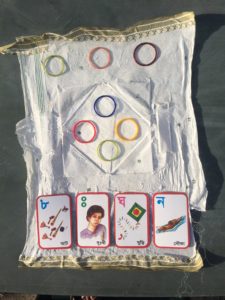
Beside Shahidul is his partner, writer, Rahnuma Ahmed. I would not be who I am without Rahnuma. She made me see the whole world with fresh eyes. She taught me to live with purpose. A magnificent mentor, a radical thinker, she sends me things to make my art. I began casting her saris with rice starch a while ago. Rahnuma, I saw you in the press conference. You are alone in your bed tonight. I can’t imagine how you feel. Posted on Instagram by Sofia Karim on 17 August 2018.
Institutions like Drik, Chobi Mela and Pathshala, which place themselves at the intersection of aesthetics and politics, have also served as models to countries like Nepal that suffer similar problems as Bangladesh. In the 1990s, Alam was already traveling across Southasia in search of photographers who could bring a new critical pedagogy to their communities. He invited leading Nepali photographers for training programmes to Dhaka and to Kolkata. He also exhibited the work of Nepali photographers in early editions of Chobi Mela. Deependra Bajracharya, Usha Titikshu and Ashesh Dangol had an exhibition alongside the likes of Reza Deghati, Pedro Meyer and Raghu Rai in the third edition themed Resistance.
Nepal today has its own digital photo archive, teaching space, and international photography festival. Alam has played a catalytic role for the Nepali photo-community not only through mentorship but also in sharing his longstanding relationships. This is why they responded to Alam’s arrest with such speed and clarity; all three major photographic societies in Nepal – photo.circle, the Photojournalists Club and the National Federation of Photojournalists – stood together in solidarity asking for his release. A more targeted protest asking for Alam’s unconditional release also took place in Kathmandu where several of Alam’s best-known photographs from Bangladesh were combined with excerpts from his writings and projected onto the walls during the BIMSTEC summit when Prime Minister Hasina Wazed was in the capital.
Photographer and media activist Shahidul Alam talks during a talk on “How to appreciate a fine art photographic print” as a part of Kathmandu International Art Festical at Patan Museum, Lalitpur on Wednesday, November 28, 2012.
Shahidul Alam at Photo Kathmandu 2016. Photo: Chemi Dorje.
Several Bangladeshi, Indian and Nepali photographers interviewed for this profile said that they look to Alam as a father figure. In him, many said, they find an intuitive sense of collaboration and the encouragement they need to seek alternative dimensions. He has guided them to ask: can they remain satisfied in silos? Should they adhere to the romantic idea of the artist situated solely in a studio? Knowing the lack of resources in their own communities, is the more radical approach not to think about what else they can do, or must do? Far from the cold calculations of the art market – infamously hierarchical, commercial and elitist – Alam has built bridges for many Southasian photographers who may have remained outsiders.
The fact that Alam has done all this while remaining grounded in Bangladesh has subtly reversed, at least in one cultural sphere, the hegemony that India, the overbearing neighbor, normally enjoys. Photographers from all over India, if not Asia, travel to Bangladesh and Nepal today to broaden their horizons – this is no small feat.
Alam has been articulating his vision for a united Southasian media community for over two decades, and his arrest revealed to NayanTara Gurung Kakshapati, the co-founder of photo.circle, Photo Kathmandu and Nepal Picture Library, just how successful he has been: “He’s able to create bridges. There are people in the Southasian photo fraternity who are speaking up and taking a stance and being vocal about this case like they’ve never done before”, says Kakshapati, “This itself is significant – him being able to bring people together in these bad times across generations, the older and younger people. WhatsApp groups that have been abuzz every day since the arrest. People are constantly trying to keep this alive and in people’s face. Finding ways of speaking up against the silencing.”
Alam has become a symbol much beyond Bangladesh in this season of arrests. In the histories yet to be written, Bangladesh will no longer be seen solely as the land of flood and famine. In a world where images are becoming the predominant language of communication, Dhaka will be remembered as the site of a seismic shift. The chances of redemption for this government in those same annals fade with each day that Alam continues to remain behind bars.
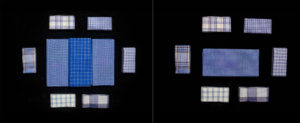
“100 lungis for Keraniganj”. #freeshahidulalam – Some of the prisoners with you are so poor they only own one lungi (sarong). They wash it and have to wait for it to dry before putting it back on again. We bought 100 lungis, to give 100 prisoners. Your friends will now each own a spare lungi. I called Parvez and asked him to lay them in patterns on black cloth and photograph them for me, before they went to their new owners. Here are some of them. Aren’t they beautiful? (Photo credit Parvez Ahmad Rony / Drik).
~ Alisha Sett is a writer and educator. She is the co-founder of Kashmir Photo Collective and Deputy Course Director for Critical Theory, Aesthetics, and Practice at Jnanapravaha Mumbai.
~Many interviewees could not be mentioned or thanked in name because of concerns for their safety.
~The article has been updated since it was published on 12 October 2018.
More readings:
Khademul Islam’s eyewitness account of Shahidul Alam’s abduction and time in prison
Our Mediafile on Bangladesh’s dwindling democratic space
Shabnam Nadiya on Bangladesh government’s crackdown on peaceful protests


